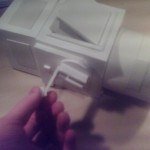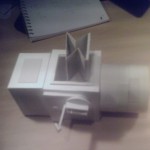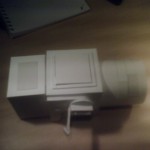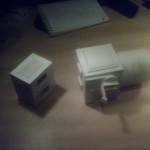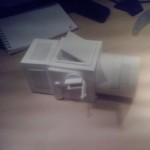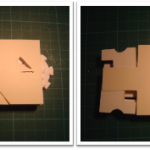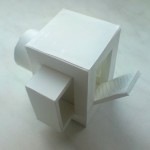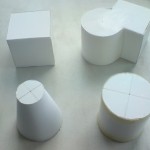Assignment DA129 Cardboard Modelling (80)
Link to OWinfo:
DA129 Cardboard Modelling (80)
Feedback form:
DA129 Cardboard Modelling (80)
What I did:
Created several models out of foam-core.
What I learned:
I learned from this assignment that doing design sketching and idea generation with cardboard, instead of sketching on paper, can lead to inspiration or even new designs. Here and here you can see examples of an idea exploration in cardboard. The exploration with cardboard enables me to sketch with my physical interaction between my hands and the cardboard. Because when I have the design in my hands, this can lead to other flashes of inspiration compared with pencil and paper. This gives me another dimension of creativity in order to generate unique designs.
This assignment made me aware of a unique way of designing and communicating my visions. I could make simple tactile designs in clay and foam before, but now also in cardboard. Unless the practical matters of the final design cannot always be realized in cardboard completely, I can roughly show my thoughts to other people in a physical way. Some examples of very simple designs can be viewed over here. In this way I can make simple and quick prototypes, which I can show to other people in my team. This can influence the selection of the ideas and communication between the team in a positive way. To confirm the story above, during the individual project I made several simple designs of foam in order to see which design is the best. I became aware that by making several physical models their suitability can be better assessed than making sketches or drawings.
Within this assignment I extended my experience in making physical prototypes. I had some experience in making models out of foam or clay before. Due this assignment I can also make proper models or prototypes out of cardboard including physical interaction. For me this was a unique way of designing, because the cardboard and scalpel forced me to operate with ultimate precision. Unless the practical matters of the final design can not always be realised in cardboard completely, I can make physical interaction possible between the model and the user by using for example bolts, turntable-knobs and sliders as you can see over here. Also the photo camera and multimedia player (link 1 & 2) I created are good examples of models including haptic interaction, because the functions could really be controlled.
Overall seen, the assignments ‘Cardboard Modelling,’ ‘Rapid Prototyping‘ and Phidgets boosted me in creating real tactile forms of communication or prototypes, in stead of just sketching or computer rendering. By making a prototype out of cardboard or plastic/wax (3D Printing), it enables me to create the real touch and feeling of a design which is closely related to the real final product. However, I became aware that only tactile forms of communications are not enough. Therefore as a designer I should combine haptic with visual and auditory ways of communication in order to create better user experience.
